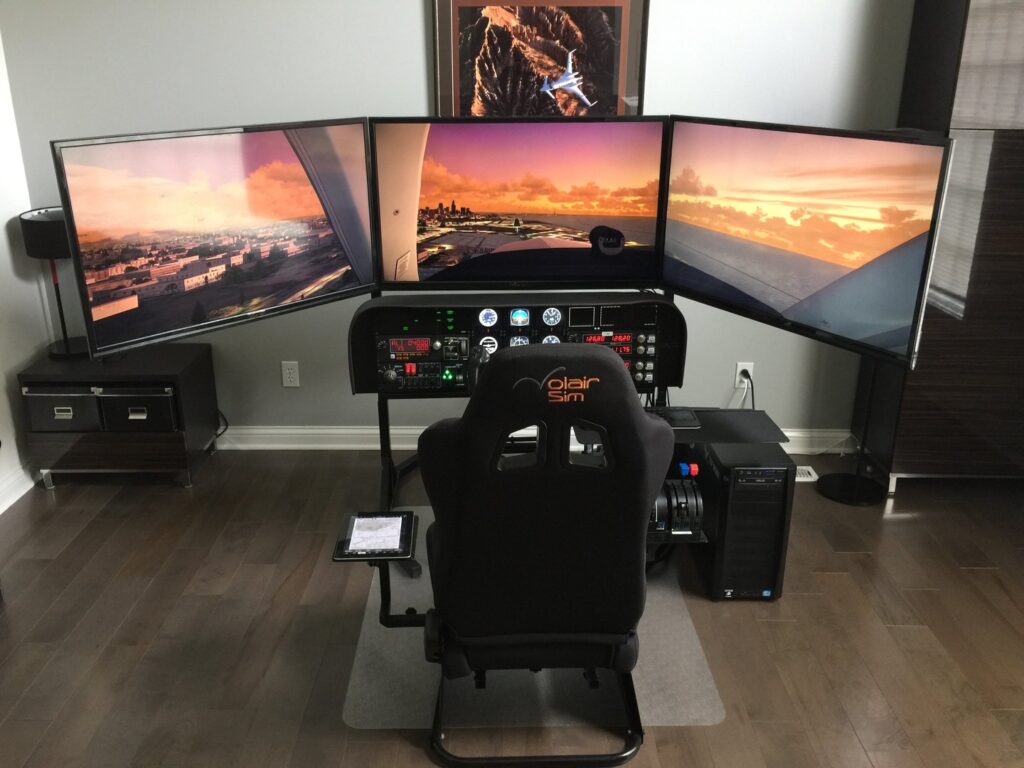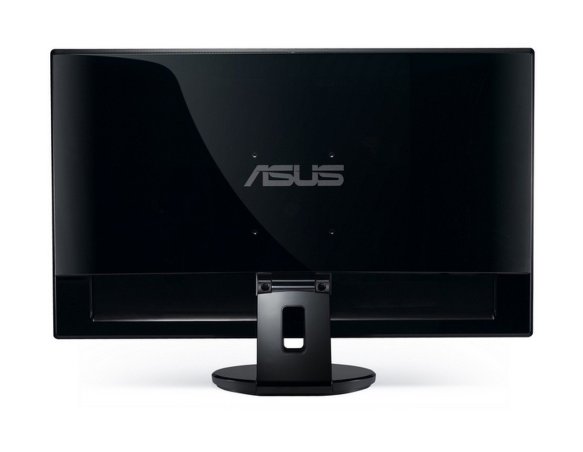Single TV vs Multiple Monitors. Does size Matter? Purchase Considerations
One of the more frequently-asked questions posed by prospective flight sim users is about multiple displays. New flight simulator users are often overwhelmed (and perhaps confused) by the plethora of options available with respect to optimal quantity, sizes, placement, and configuration of monitors or TVs to use with a flight simulator. Therefore, it is appropriate to devote some time discussing various hardware aspects of the visuals used with a flight sim set-up. We will try to present the reader with substantiated justifications for opinions shared here. The following recommendations assume a single-person simulator as opposed a dual student/instruction station and is focused on a reasonable simple and cost-effective general-aviation set-up vs. elaborate jetliner cockpit.

The question that is asked most often is, “Are multiple (smaller) displays better than one large one?” The following may be a highly biased answer but in our opinion (supported by feedback from hundreds of customers) multiple displays, irrespective of the cost and space considerations, are always a better bet than a single (even very large) display. There are several reasons for this. First, and you have to trust our word on this one, multiple displays offer a much better sense of immersion vs single monitor or even a large TV. By having the external view span most of the user’s visual field, the sense of flight and being inside the cockpit is greatly enhanced. Even with a triple monitor set-up arranged in an angled “U” shape, a good portion of flight simulator user’s peripheral vision is covered by the left and right monitors. Interestingly, while larger monitors are better than smaller ones, a good level of immersion can be achieved with just three 27” monitors. Correspondingly, based on our research, going much beyond 40”-42” in size for a triple installation offers little additional benefit from the immersion perspective although undoubtedly increases the “wow” factor from the onlookers.
The more pragmatic (pilot-specific) aspect of triple monitor set-up is the ability to look through the left (or right) “windows” while making turns from a downwind leg to base leg and from base to final. During a standard traffic pattern, pilot glances through the left (if in the left or standard traffic pattern) or a right window (for the right traffic pattern) periodically so that he or she can appropriately start the turn. Having the left and right monitors and setting up the cockpit view appropriately, allows the user to see the runway over the shoulder just like in the real aircraft. This is very useful during primary instruction when a student is learning to fly a proper traffic pattern as well as in advanced instruction where students are practicing, for instance, circling approaches.
Of course, users with single monitors set-ups will be quick to point out that using a hat switch or a Track-IR system allows user to quickly change views and that is of course true. The problem is that every time a view is changed, in our opinion, the sense of immersion is instantly lost and therefore, the flight sim experience is compromised. Lastly, the switched view approach does not prepare the flight simulator user for the expected view when flying physical aircraft.
The next logical questions that comes up is, “How many displays should one have?” We found that triple displays (we are discussing external views only) are often sufficient to provide an excellent immersion while keeping cost and space considerations to minimum. Of course, having five external monitors would be better but we are reaching, to borrow an economic term, a law or increasingly marginal returns.
Some may ask, “What about curved displays?” We think that they are a nice and modern, albeit costly, upgrade. Again, triple “traditional” display set-up will offer more immersion than a single curved one, at least at current level of the curved technology where the level of curvature/wrap-around is pretty minimal.
Lastly, let’s discuss the VR as an alternative to conventional displays. VR as a technology for gaming and an alternative to traditional displays is definitely here to stay and probably will have a very significant impact on the future of flight simulators. The immersion factor is obviously unparalleled, the space and cost savings can be significant. Why isn’t everyone abandoning monitors or TVs and jumping onto VR platform then?
Irrespective of the biological factors (nausea), there are few obstacles that remain to be solved for VR to be a serious alternative for flight simulation. First, the graphical resolution of today’s VR hardware does not quite match a high-quality monitor or TV set-up. Second, the virtual-physical interface in an aircraft cockpit needs improvement. Currently, the support for interaction with physical switches or controls is still in its infancy. A glove-like or (even better) glove-less controller that would allow the user to naturally interact with the physical world is a research subject to every VR hardware manufacturer. However, the implementation seems, as of today, a lot more difficult than anticipated. While for general-purpose gaming the VR hand-held controller is probably sufficient, it is a deal-breaker for achieving sense of realism in the flight sim. In sum, flight simulation needs a “merged-reality” solution. Otherwise we are back to the mouse-clicking solution from the legacy flight sim days.
Now that we’ve explained the benefits of multiple displays, let’s offer few practical words of advice on physical monitor or TV selection. In short, try to find monitors or TVs with as thin of a bezel as possible to achieve the optimal “wraparound” effect. Second, if you are planning to mount your monitors or TVs, you need to ensure that the monitor has a VESA mount which is a standardized four-hole pattern on the back of the monitor and TV. TVs, especially large ones, all have the VESA pattern on the back since they are meant to be hung on a wall but the monitors do not always have the VESA pattern so you must check prior to purchase.

Lastly, let us address the question, “Should I buy a TVs or computer monitor?” Given dropping TV prices, many of the flight sim users are tempted to buy a TV in-lieu-of a monitor especially that one can often purchase larger TV for the same price of a smaller monitor. The answer is, it depends. If all of your sim usage is going to be dedicated for flight simulation, TVs are probably fine but keep in mind that TVs typically have lower refresh rates and input lag times as compared to monitors so playing fast-paced games on a TV will not yield the same quality and smoothness as on a gaming monitor. Also keep in mind that a pixel density of a comparable resolution monitor is much higher than on TV (ever wondered why text does not appear as clear on a large high-definition TV as compared on your monitor) so if you opt for some really large TVs and position them close to you, you may be disappointed. To sum up, either stick with quality monitors or keep the TV size reasonable (again 40”-43” seems like a sweet-spot for high-definition TVs for simulator use).
| Cookie | Duration | Description |
|---|---|---|
| cookielawinfo-checkbox-analytics | 11 months | This cookie is set by GDPR Cookie Consent plugin. The cookie is used to store the user consent for the cookies in the category "Analytics". |
| cookielawinfo-checkbox-functional | 11 months | The cookie is set by GDPR cookie consent to record the user consent for the cookies in the category "Functional". |
| cookielawinfo-checkbox-necessary | 11 months | This cookie is set by GDPR Cookie Consent plugin. The cookies is used to store the user consent for the cookies in the category "Necessary". |
| cookielawinfo-checkbox-others | 11 months | This cookie is set by GDPR Cookie Consent plugin. The cookie is used to store the user consent for the cookies in the category "Other. |
| cookielawinfo-checkbox-performance | 11 months | This cookie is set by GDPR Cookie Consent plugin. The cookie is used to store the user consent for the cookies in the category "Performance". |
| viewed_cookie_policy | 11 months | The cookie is set by the GDPR Cookie Consent plugin and is used to store whether or not user has consented to the use of cookies. It does not store any personal data. |
SUMMER SPECIAL: PURCHASE THE COCKPIT AND EITHER THE AVIONICS PANEL OR THE TRIPLE DISPLAY STAND AND GET ADDITIONAL $100 OFF YOUR ORDER (USE COUPON VSMSAP). ALSO, TAKE ADVANTAGE OF DISCOUNTED $99 SHIPPING ON CHASSIS! LIMITED TIME OFFER SO ACT NOW! Dismiss